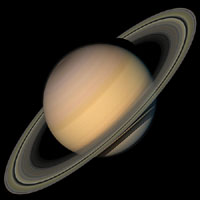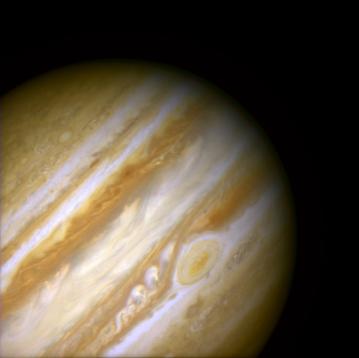The heavy elements are concentrated in the core of the planet Saturn, while in Jupiter they are scattered throughout the planet, the core of which is very small or missing

Pictured above: The sixth planet in the solar system Saturn. Pictured below: the fifth planet Jupiter.
The gas giant planets Jupiter and Saturn apparently formed about five billion years ago in completely different ways.
This is what a scientist from the Los Alamos National Laboratory of the University of California claims. The scientist developed comprehensive computer models, based on experiments in which the element hydrogen was compressed to pressures almost like the pressures found inside these two planets.
Didier Saumon from the Department of Applied Physics at Los Alamos, who worked together with a French colleague, created models that stated that the heavy elements are concentrated in the core of the planet Saturn, while in truth they are scattered throughout the planet, whose core is very small or missing. The study, published in this week's issue of the Astrophysical Journal, showed that elements with a high melting temperature such as iron, nitrogen, carbon, nitrogen and oxygen are concentrated in Saturn's core but scattered throughout Jupiter. From this it can be concluded that these two planets were created through different processes.
Saumon gathered information from several experiments in the compression of gases, which were conducted recently. These experiments showed how hydrogen behaves at pressures millions of times greater than atmospheric pressure, pressures close to the pressures found in gas giants. These experiments, carried out in recent years at the national laboratories in the United States and Russia, for the first time succeeded in measuring with high precision the equations of state of simple liquids such as hydrogen in the areas of high pressures and densities, in which deuterium, an isotope consisting of a hydrogen atom with an additional neutron, turns into an ion.
Saumon, who worked with T. Guillot (Guillot) from the Observatory de la Côte d'Azur in France, developed about 50,000 models for the internal structures of the two gas giants. The models include every possible change, consistent with observations and laboratory experiments.
"Data from spacecraft that studied the planets provided us with indirect information on what is known to be happening inside Jupiter and Saturn. Now we hope to learn more from Cassini, which has just entered Saturn orbit," Saumon said. "We selected from the multitude of models only those that correspond to the observations."
Jupiter, Saturn and other gas planets are made of gas, like the Sun. About 70 percent of their mass is made up of hydrogen, with the rest mostly made up of helium and small amounts of heavier elements. Since the equations describing the state of hydrogen at high pressures were not well understood, calculating the internal state of the gas giants proved to be a difficult task.
Saumont and Guillot limited their models according to the results of the deuterium experiments and thus succeeded in reducing ambiguities from the equations that describe the state of hydrogen. These equations are the key element, needed to improve the models of the structure of the planets and how they are formed.
"We tried to include every possible change that the experimental data of the deuterium compression might allow," explained Saumon.
By estimating the amount of heavy elements and how they are distributed within Jupiter and Saturn, the models provide a better picture of how the planets formed as hydrogen, helium and other heavy elements were swept away from the nebula, which swirled around the Sun billions of years ago.
"There was general agreement on the difference between the cores of Jupiter and Saturn," Saumon said. "What is innovative here is the scale of these models. We were able to rule out or quantify many open issues, so that we now have a solid estimate regarding the range in which the real data will be obtained for hydrogen, and hence also for metals with a high melting temperature and other elements."
"While we can't vouch for our models being accurate, we know pretty well how inaccurate they are," he added.
The results from the models will help guide measurements, which will be conducted by Cassini and other interplanetary spacecraft, which they proposed to send to Jupiter.
Los Alamos National Laboratory is operated by the University of California for the National Nuclear Security Administration (NNSA) of the United States Department of Energy (DOE). The laboratory works in collaboration with the NNSA Sandia and Lawrence Livermore National Laboratories in order to assist the operation of the NNSA.
Los Alamos develops and applies science and technology to ensure the safety and reliability of the United States' nuclear deterrent force; Reduce the threat of weapons of mass destruction, biological terrorism and terrorism in general and solve national problems related to defense, energy, environment and infrastructure.
Translation: Dikla Oren
For a press release on behalf of Los Alamos

